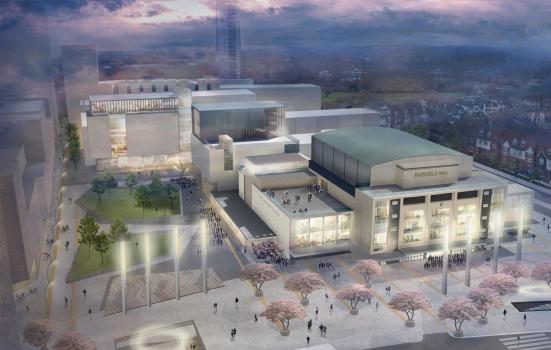The days when The Beatles played Croydon may be a distant memory, but the council’s regeneration plans hope to bring culture – and audiences – back to the borough’s heart. Paula Murray explains how.

From my desk on the sixth floor of the council offices, Croydon’s skyline is quite amazing. It has towers clustered in the centre, Victorian rooftops to the north and a suburban sprawl to the south, all linked together by over 100 parks and green spaces. It is a borough of enormous contrasts that’s been on a half-century-long rollercoaster ride of cultural change.
When we spend so much of our time looking at screens and in our own homes, spaces to gather, attend events and share common experiences are important
Croydon’s cultural boom years were the 1960s and 1970s, when the then-new Fairfield Halls and a collection of successful smaller venues like The Greyhound hosted the biggest and the newest names of the time (The Beatles, The Who, Queen, Jimi Hendrix, The Ramones, Kraftwerk and Talking Heads). Croydon also attracted other creative geniuses, such as visual artist Jamie Reid and impresario Malcolm McLaren.
But improved connections to central and north London saw audiences for live entertainment increasingly drawn to the West End, and Croydon’s evening offer shifted to big nightclubs. Many smaller live venues just couldn’t compete. Like many outer London suburban boroughs, Croydon saw commercial investment decline and as old, outdated office stock was emptied of tenants, the early evening economy was hit by a lack of office workers.
Investment and regeneration
But now it is all changing. Over the next five years, more than £5bn will be invested in the borough’s regeneration, creating 23,500 new jobs, 9,500 new homes, a cultural quarter and one of Europe’s largest leisure and retail destinations.
Croydon needs to develop and improve. It needs more housing, jobs and beautiful public spaces. Crucially, what is also needed at the heart of this change is for the town to develop and retain its culture. If it doesn’t, then it risks losing its personality, energy and distinctiveness. It’s just not enough in life to have only housing and shopping.
New public realm schemes will only work if they are lovely to be in and attract footfall – informed by good design with thought given to natural spaces for events and public gatherings. When we spend so much of our time looking at screens and in our own homes, spaces to gather, attend events and share common experiences are important.
Culture at the heart
Another important thing a town centre should do is stay active once offices and shops close for the day. The evening and night-time economy speaks volumes about how people feel about an area. That is why Croydon Council is looking hard to find ways of supporting small-scale live music venues and building stronger relationships between the police, licensing teams and those who are keen to book and promote quality performers.
The council’s £3m loan to Boxpark Croydon, to create a 2,000 capacity space filled with quality food, craft beers and performance space underlines this commitment.
We are lucky in Croydon that we don’t have to make everything up from scratch. You can’t make up historical narratives and talented organisations and artists, a burgeoning music industry or an intense cluster of top-class Asian dance – all of the starting points for cultural growth.
Refurbishment of Fairfield Halls
There is already good architecture to work from and Fairfield Halls is a centrepiece in the development that is undergoing substantial refurbishment.
The £30m council investment will see improvements to its concert hall, Arnhem Gallery, Ashcroft Theatre and the main foyer and front-of-house spaces. It will add new studio space and replace the mechanical engineering services and façade treatment. All in all it will be a substantial re-upholster, repaint and revamp to return it to its stylish 1960s splendour.
Although the building is not listed, its heritage has been a driving force. The design team, Rick Mather Architects, won a New London Architecture award for Fairfield Halls design in the Conservation and Retrofit category. Its design celebrates Fairfield’s past and its close links with the Royal Festival Hall, while at the same time ensuring audiences will be comfortable.
The venue closed in the middle of July, the hoardings are up and the asbestos scoping is nearly completed. Harrison & Harrison is coming in next week to build protective walls around the organ and take away some of its more tender bits for safe keeping until the refurbishment is done.
Over the next few months the council will be appointing an operator for the building when it is ready to retake its place as the heart of Croydon’s cultural landscape in 2018.
A mixed reputation
So we know where we are starting from and that we have a way to travel. Croydon’s reputation is a mixed thing and you can meet both a slight sneer and a fierce Cronx pride in the space of a day – and both are better than indifference. Love Croydon or not, one thing’s for sure, there’s too much happening here over the next few years to ignore it.
Paula Murray is Creative Director at Croydon Council.
www.croydon.gov.uk





Comments
Proud to work i... replied on Permalink
All change in Croydon
Proud to work i... replied on Permalink
All change in Croydon
maurice.davies@... replied on Permalink
Croydon clocktower